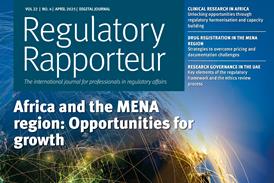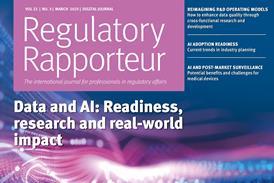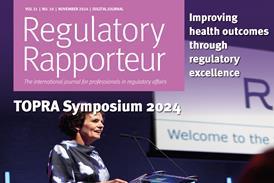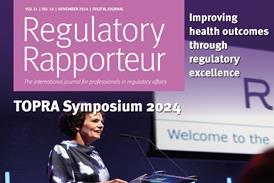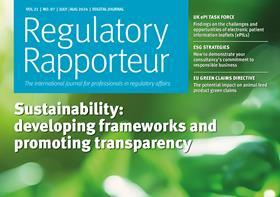
Regulatory Rapporteur
July/August 2024 | Volume 21 | No.7
In this bumper July/August edition of Regulatory Rapporteur, we focus on sustainability and, in many aspects, we build upon our June theme of access to medicines. Sustainability in pharmaceuticals encompasses a broad range of practices aimed at minimising the environmental, social and economic impact of pharmaceutical production, distribution and consumption.
The most important elements include:
- green chemistry and eco-friendly manufacturing
- sustainable supply chain
- product lifecycle management
- waste and pollution control
- patient and public engagement
- ethical and social responsibility
- regulatory compliance and transparency
- innovation and research.
These elements, when integrated into the pharmaceutical industry, can help create a more sustainable and responsible sector, balancing the need for innovation and public health with the preservation of the environment and social equity. We touch upon many of these elements in our focus articles.
In May 2024, the European Commission presented the European Union’s Ecodesign for Sustainable Products Regulation (ESPR). This represents a significant shift in its approach to sustainability and product design, aimed at reducing the environmental impact of products throughout their lifecycle. The regulation builds upon, and eventually replaces, the earlier Ecodesign Directive, and is a cornerstone of the EU’s Green Deal and circular economy action plan (CEAP). Key aspects include:
- an expanded scope, including textiles, furniture, and even some non-energy-related products
- sustainability requirements with products designed for durability, reparability and recyclability
- digital product passports (DPPs), which will provide detailed information on each product’s sustainability credentials to enhance transparency and allow consumers to make more informed choices
- a ban on the destruction of unsold goods to combat waste and drive companies towards more sustainable inventory and waste management practices
- implementation and compliance phased in over 18 months, with some regulations becoming enforceable as early as 2027.

This regulation is set to impact a wide array of industries, compelling companies to innovate and adopt more sustainable practices, while also ensuring that the products they offer meet rigorous environmental standards. However, it is of significant note that the ESPR specifically excludes several categories of products, including those that are subject to separate regulatory frameworks like food, feed, medicinal products (including veterinary medicinal products), and products related to human health and safety, such as medical devices. These exclusions ensure that the ESPR focuses on products that have significant environmental impacts but that are not already heavily regulated by other EU laws tailored to ensure safety and efficacy, such as the Medical Devices Regulation (MDR). In this edition, we look specifically at the pharmaceutical industry and assess if we are sufficiently addressing sustainability.
This focus edition also coincides with the implementation of the revised European guidance concerning environmental risk assessments (ERAs). Our article by Sharon Robinson and Kadi Kuuskmae-Perry from DLRC Ltd discusses and analyses the key changes of this revised guidance which becomes effective on 1 September 2024.
In prior sustainability editions of Regulatory Rapporteur, our attention has been on green pharma and the emerging environmental implications of our industry. This is still very relevant, with the World Health Organisation (WHO) stating that: “Climate change is the greatest challenge of the 21st century, threatening all aspects of the society in which we live.”[1] Within many of our featured articles we see a direct causal relationship between climate change and human health. Of note, for an industry which is focused on patient health, wellbeing and safety, the delivery of healthcare significantly contributes towards negative environmental impacts, including climate change. The sustainability imperative for the healthcare sector is detailed by Michael Kipping, Michelle Sullivan, Peter Bannister and Rich Shaw who highlight that, if the global healthcare sector were a country, it would be the fifth largest contributor to climate change. Furthermore, the carbon footprint of the NHS in England is equivalent to that of the whole of Croatia.[2]
In contrast to our previous Regulatory Rapporteur green pharma editions, we now develop the sustainability concept to recognise the environmental pillar as a core everyday element of our regulatory role, but also include the other pillars of society and economy. Again, we look to the foundations of the WHO and its definition of an environmentally sustainable healthcare system as “a health system that improves, maintains or restores health, while minimising negative impacts on the environment and leveraging opportunities to restore and improve it, to the benefit of the health and well-being of current and future generations.” This ecosystem is only feasible when we incorporate economy and societal factors into the mix.
The relevance of sustainability in regulatory affairs consultancies is discussed by Shelley Morelli and Zeb Younes. They focus on the business value associated with implementing a framework of environmental, social and governance (ESG) factors to approach and evaluate a company’s sustainability and ethical impact. These factors can help stakeholders and investors evaluate a consultancy’s commitment to responsible business practices and their effects on society and the environment.
Bengt Mattson, Co-chair of the three European pharmaceutical trade associations’ (AESGP, EFPIA and MfE) Task Force on pharmaceutical and environmental impacts, reflects on sustainability in the regulatory environment. In this interview, he considers the economic models, and the drivers for companies to engage in, and embrace, sustainability.
Cormac O’Prey expands on these themes in his article on sustainable design and manufacture in medical devices. While sustainability in the medical device and healthcare sector is now a recognised concept, there is still a lack of clarity over what it entails, how to measure it and how to achieve it. However, sustainability can be disruptive to businesses and its effects can be widespread, so careful change management is required in order to succeed.
Continuing on this theme, Jocivania Oliveira da Silva and Marielle Fournier look at the new approach methodologies for the biological safety assessment of medical devices, which are being actively developed to supplement or replace in vivo testing as part of the drive towards the three Rs of replacement, reduction and refinement of animal experiments.
Within the veterinary sector, Sebastien Oguey, Clementine Oguey and Vera Houriet report on the European Green Deal as the EU’s approach to accelerating the ecological transition of climate change and climate neutrality by 2050. Their article introduces the concept of lifecycle analysis (LCA) and the potential business advantage to companies making properly substantiated green claims.
However, it would be remiss to publish an article on sustainability and not cover electronic labelling and indeed, this falls within the topic of patient and public engagement. It is estimated that replacing paper-based leaflets could reduce carbon emissions by 90% as, on average, a paper-based package leaflet causes 7g of CO2.[3] Furthermore, multiple national health authorities are advocating for electronic labelling. NOMA, the Norwegian Medicines Agency, has reported that 60% of people know that package leaflets are available digitally and, of these, 70% have read the digital version. Consequently, they are working with multiple national organisations, including the Association of the Pharmaceutical Industry in Norway (LMI) and the Norwegian Pharmaceutical Product Compendium (Felleskatalogen) to promote use, particularly in smaller countries with shared packs.[4] ANVISA, the Brazilian national health authority, has also opened a public consultation on its proposal to establish the transitory guidelines for the implementation of digital leaflets and waiver of printed leaflets. This pilot would initially cover only medicines with restricted use in healthcare establishments and free samples.
TOPRA is therefore thrilled to publish the UK ePI Task Force evidence review on electronic patient information leaflets (ePILs), which has been prepared by Marie Woe, Erika Aparicio and Kathryn Sharpe and supported by the Association of the British Pharmaceutical Industry (ABPI), the British Generic Manufacturers Association (BGMA) and PAGB, the consumer healthcare association.
We build on this white paper with an article from Sampath Kumar Belide, Arun Arya, Kirti Yadav, Vivek Tomar and Allison Gillespie, which considers the more global aspects of e-labelling. This looks at the need to prioritise the revolution of the labelling sector and to embrace technology including digitalisation and automation.
Finally, building upon the June issue, our standalone article by Elem Ayne discusses the role of the Person Responsible for Regulatory Compliance (PRRC). This role was defined with the publication of the Medical Device Regulation (EU) 2017/745 (MDR) and the In Vitro Diagnostic Medical Device Regulation (EU) 2017/746 (IVDR). To ensure a harmonised understanding of these regulations, TEAM-PRRC, a European non-profit organisation, has been created and Elem discusses the advantages of joining the association.
As summer brings opportunities to relax and reflect, it’s also an ideal time to consider how you can be an environmental steward, regardless of your role within the regulatory profession or the specific sector. By aligning your actions with sustainability goals, you will help shape a better world for future generations. Every choice, no matter how small, has the potential to contribute to global sustainability.
References
[1] World Health Organisation (WHO) (2018) COP 24 special report.
[2] NHS England (2022) Delivering a ‘Net Zero’ National Health Service.
[3] Dobers K., Gerbsch N., Mandry T. and Preut A. (2023) ‘Carbon footprint of package leaflets’ Pharm. Ind., 85, Nr. 11, pp. 1046–1054.
[4] Norwegian Medical Products Agency (2024) Use digital package leaflets.


